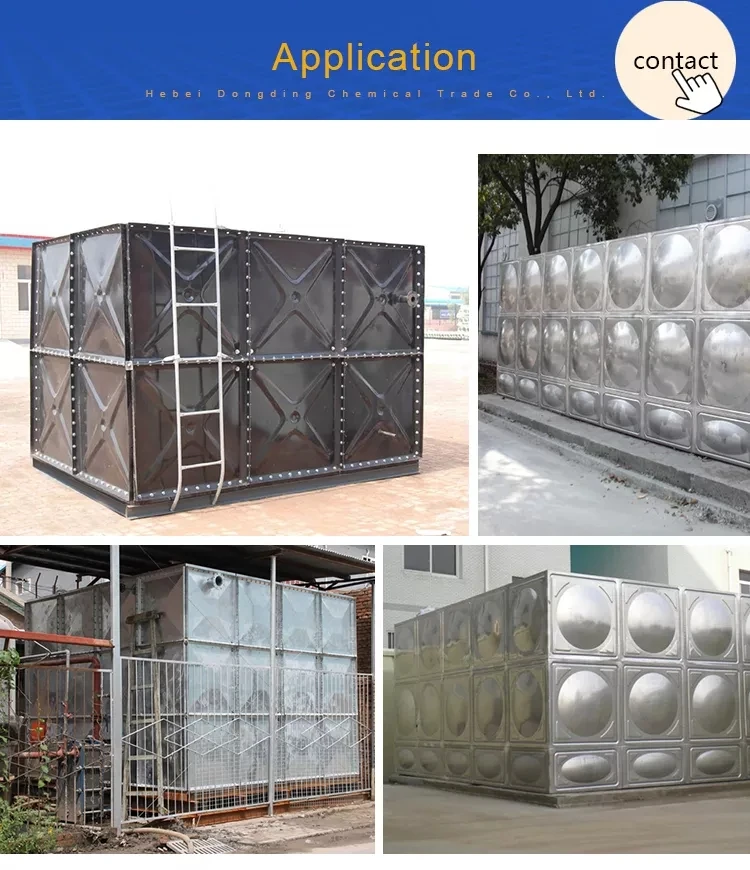


Sectional Water Storage Tanks A Comprehensive Overview
In contemporary water management systems, sectional water storage tanks have emerged as a pivotal solution for various applications ranging from residential to industrial uses. These tanks are designed to optimize water storage, ensuring efficient supply and management while also providing flexibility in installation and maintenance. This article explores the characteristics, advantages, and applications of sectional water storage tanks.
What are Sectional Water Storage Tanks?
Sectional water storage tanks are constructed using pre-fabricated panels, which are assembled on-site to create a comprehensive storage unit. These tanks are generally made from materials such as fiberglass, steel, or polyethylene. The sectional design allows for easy transportation and installation, particularly in areas with space constraints or challenging access. The panels can be modular in design, enabling customization based on specific storage capacity needs.
Key Features and Benefits
One of the primary advantages of sectional water storage tanks is their adaptability. Since they can be easily expanded by adding more sections, they offer a flexible option for changing water demand. This modularity means that as water needs grow, the system can be upgraded without the need for a complete replacement.
Additionally, sectional tanks are designed to withstand various environmental conditions. Many models are constructed to resist corrosion, UV radiation, and severe weather. The use of high-quality materials ensures that these tanks have a long service life and require minimal maintenance. This durability is particularly beneficial in areas with harsh climates where traditional water storage solutions may falter.
Moreover, these tanks can be tailored to meet specific regulatory requirements and safety standards. For instance, some sectional water storage tanks are lined with non-toxic coatings to ensure the water’s quality and safety for human consumption. This is vital for municipalities and companies aiming to provide clean drinking water to their communities.
Environmentally Friendly Option

In today’s eco-conscious world, sectional water storage tanks also represent a more sustainable option. They are designed for efficient water storage and minimize waste through secure containment. By reducing the risk of leaks or contamination, these tanks help in maintaining the purity of stored water. Additionally, many sectional tanks are manufactured using recyclable materials, thereby lowering their carbon footprint during production.
Applications of Sectional Water Storage Tanks
Sectional water storage tanks are immensely versatile, catering to a wide range of industries and applications. They are commonly used in municipal water supply systems, irrigation projects, and fire protection reserves. Construction sites also utilize these tanks for temporary water storage, ensuring a consistent supply for various operations.
In residential settings, sectional tanks provide homeowners with reliable water storage solutions, especially in areas prone to water shortages or supply disruptions. They are also frequently utilized in commercial establishments, such as hotels and restaurants, where the demand for water can fluctuate significantly throughout the day.
Industrial applications are vast, with sectors like agriculture, food processing, and manufacturing benefiting from the efficient water storage capabilities of sectional tanks. In these contexts, they may be used for both potable and non-potable water storage, showcasing their versatility and reliability.
Conclusion
Sectional water storage tanks represent an essential component of modern water management systems. Their modular design, durability, and flexibility make them ideal for various applications, whether for residential, commercial, or industrial use. As the demand for sustainable and efficient water storage solutions grows, sectional water storage tanks are poised to play a crucial role in addressing the challenges of water management.
By investing in these tanks, communities and businesses can ensure a reliable water supply while adhering to environmental standards, ultimately contributing to a safer and more sustainable future. As technology and materials continue to evolve, the capabilities of sectional water storage tanks will only expand, further enhancing their significance in water conservation efforts worldwide.